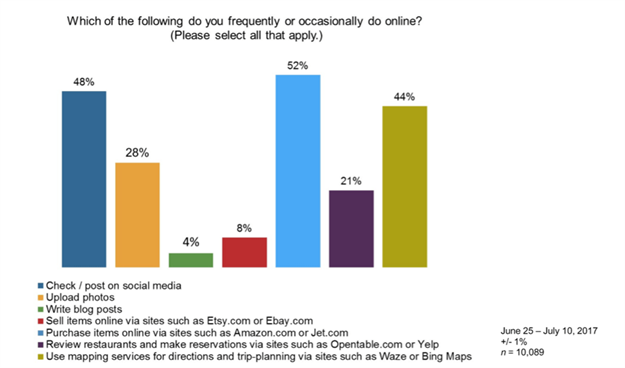Does Everyone Shop Online, Really?

by Amberly Dressler
05 Sep, 2017
Similar to how social media can become a narrow tunnel showcasing only content users most likely want to see, surveys about online behavior can do the same.
Many times, surveys conducted do not account for different socio-economic factors - think of a tech company asking its employees ( who likely make higher wages than the general population and are more likely to embrace digital experiences) how frequently they shop online or that same tech company asking its B2B customers the same question ( also likely have higher wages and are more prone to embrace digital experiences). In other words, what's the point if the survey does not include factors like wages, location, job title and even race?
Website Magazine had the opportunity to participate in a tele-press conference hosted by The Internet Innovation Alliance (IIA), which presented CivicScience's findings of its objective, large-scale study of U.S. consumers and their online behaviors. Here are some highlights:
+ From the selection criteria provided, the number one online activity is buying and selling, followed closely by check/post to social media and then using mapping services to round out the top three.

+ When breaking down the top online activities by ages, races and residential area, however, we start to see some differences. For example, respondents 30 years or older indicate their most frequent online activity as purchasing items online; those younger than 30 are more likely to check/post on social media more frequently. As shown in Civic Science's graphic below, social follows shopping closely in those 30-plus age groups but shopping is still the top activity.

+ Where online activities start to broaden is when looking at race differences. By this survey's account, for example, the Hispanic market is shopping online far less frequently than all other races (and show lower numbers in other areas too).

+ Finally, where people live also plays a role in their online behavior but not as drastically as one might expect. For example, it could be hypothesized that those without access to a wide selection of stores (perhaps in rural areas) could rely on ecommerce more than suburb shoppers. Across the board, however, there are not drastic fluctuations.

+ If this survey tells Internet retailers one thing it is that the blending of two top online activities (social and shopping) is likely where money will be made this year and beyond. While it is our recommendation to bring social users to your site (versus housing all activity on a third-party platform that you do not own and cannot control), there is money to be made by acting on some of today's social-commerce advancements.
Continue Learning:
Many times, surveys conducted do not account for different socio-economic factors - think of a tech company asking its employees ( who likely make higher wages than the general population and are more likely to embrace digital experiences) how frequently they shop online or that same tech company asking its B2B customers the same question ( also likely have higher wages and are more prone to embrace digital experiences). In other words, what's the point if the survey does not include factors like wages, location, job title and even race?
Website Magazine had the opportunity to participate in a tele-press conference hosted by The Internet Innovation Alliance (IIA), which presented CivicScience's findings of its objective, large-scale study of U.S. consumers and their online behaviors. Here are some highlights:
+ From the selection criteria provided, the number one online activity is buying and selling, followed closely by check/post to social media and then using mapping services to round out the top three.

+ When breaking down the top online activities by ages, races and residential area, however, we start to see some differences. For example, respondents 30 years or older indicate their most frequent online activity as purchasing items online; those younger than 30 are more likely to check/post on social media more frequently. As shown in Civic Science's graphic below, social follows shopping closely in those 30-plus age groups but shopping is still the top activity.

+ Where online activities start to broaden is when looking at race differences. By this survey's account, for example, the Hispanic market is shopping online far less frequently than all other races (and show lower numbers in other areas too).

+ Finally, where people live also plays a role in their online behavior but not as drastically as one might expect. For example, it could be hypothesized that those without access to a wide selection of stores (perhaps in rural areas) could rely on ecommerce more than suburb shoppers. Across the board, however, there are not drastic fluctuations.

+ If this survey tells Internet retailers one thing it is that the blending of two top online activities (social and shopping) is likely where money will be made this year and beyond. While it is our recommendation to bring social users to your site (versus housing all activity on a third-party platform that you do not own and cannot control), there is money to be made by acting on some of today's social-commerce advancements.
Continue Learning:

Amberly Dressler
Head of analyst relations, public relations, customer advocacy (People Heroes), customer community, content marketing (full funnel/lifecycle), content operations and optimization, reputation management and social media. Leads a team of nine superstars to exceed our goals multi-fold.







